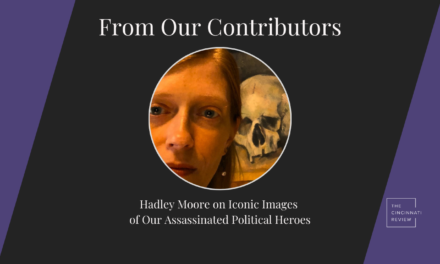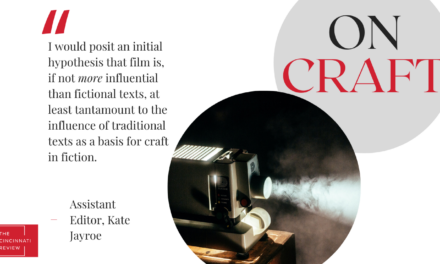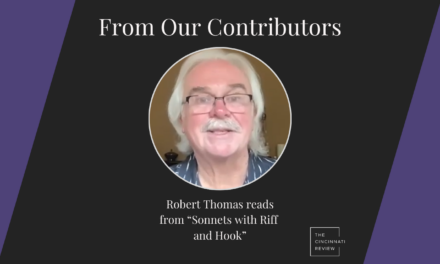
Associate Editor Haley Crigger: What makes second-person narration so compelling? What makes it so polarizing? In this essay, Michalski reflects on her own habit of addressing the reader, a fondness for the second person that became impossible to ignore after the publication of her latest short story collection, The Company of Strangers (Braddock Avenue Books, 2023). Here at CR, our editorial team had a similar experience when we realized, in the process of laying out Issue 20.1, that it will feature three pieces of prose written in the second person: Amanda DeMatto’s story “Web,” Katherine Heiny’s story “Twist & Shout,” and Jer Xiong’s essay “Calling.” There’s real artistic and intellectual pleasure to be found in such synchronicity, and we’re grateful to Jen Michalski for writing so lucidly about what we can hope to make of it all.
When another writer pointed out to me in an interview that five of the fifteen stories in my new collection, The Company of Strangers (Braddock Avenue Books, 2023), were written in the second person, I had a small panic attack. How had I not noticed? Second-person point of view in fiction is kind of like the Yankees or Elon Musk—either you’re a huge fan, or you forbid their names spoken in your presence. Sure, some writers used it with great success—Jay McInerney’s novel Bright Lights, Big City (Penguin Random House, 1984) and Lorrie Moore’s collection Self-Help (Penguin Random House, 1989) come to mind. But the second person is not for everybody, and certainly never, everyone warns, when writing a novel.
But why is it so often for me? Part of it may be exposure to it at a formative age. As a teenager in the mid-’80s, I read the aforementioned Bright Lights, Big City and was surprised and excited that a story could be told in this way. Along with fellow ’80s-literary-brat-packer Bret Easton Ellis, McInerney marked my transition from J. R. R. Tolkien and Sweet Valley High to literary fiction. As an aspiring fourteen-year-old novelist, I copied their slick, stylistic prose—although more in the first person, like Ellis, than in McInerney’s second person.
As I got older, however, I discovered a greater richness in the variety and cadence of the second person. With good reason—it’s less formal, more conversational. The tone can feel very playful or interrogative, or somewhere in between. Sometimes, it even feels like spoken-word poetry. Although some writers can do all of this in the third person—think Rick Moody’s Purple America (Back Bay Books, 1999)—for me there’s a slight detachment from the character in the third person, an ability to walk away at the end. To remind oneself it’s just a story.
Second person can be a great compromise. It’s more immediate than third but not so immediate in that you are stuck in another person’s point of view, as in first person (particularly if the person is unlikable—am I the only person who finds Holden Caulfield whiny?). And part of why I write is to find and relate our similarities, put readers in others’ shoes. Sometimes the best way to do that is to make them a character. Second person is gentle tug toward empathy: “You, dear reader, have been in this situation, haven’t you?” Or sometimes more forcefully: “Well, surprise, you are in this situation.”
As a queer writer, it’s extremely important for me to create empathy for my characters, to invite readers to inhabit them and discover that the same dreams, the same hurts and frailties, come in all types of packages. Is it any wonder that other marginalized writers are receptive to the second person as well? Valerie Valdes writes in her essay, “Why Writing Second Person POV Appeals to Marginalized Writers,” that “We already expect to be presented with characters unlike ourselves, requiring that we engage with them.” Is turnabout not fair play?
In the first drafts of my collection’s title story, I wrote Casey, the main character, without a defined gender. At the time, I was interested in readers’ preconceived notions—would readers judge Casey more harshly if Casey were a man who slept with his brother’s girlfriend? Would they be more forgiving if Casey were a woman who slept with her brother’s girlfriend? Writing it in the third person, however, became cumbersome, nearly impossible, so I changed to second person. Eventually I did assign Casey a gender, after a lengthy discussion with the journal editor who accepted the story (for an entirely unrelated reason), but I kept the point of view in second person. I wanted the reader to experience Casey’s isolation, the consequences of a bad decision, the fear of losing the only family one has, and the final understanding that family is more than blood as their own.
Familial rejection is something that queer people, young and old, have experienced. It’s traumatic and life changing, and, as a writer, I often find that rejection, that isolation, seeping into my own stories. Am I examining my own sadness closer, hoping for a cathartic letting go, or do I want others to experience it, go my way for a little bit, to understand where I’m coming from, or at least meet me halfway?
It’s always good to be aware of one’s tendencies as a writer. Now that I’m more aware of my tendency to rely on the second person, I’ve been making an effort to approach stories in other ways, to challenge myself to create that emotionality in all points of view. But I don’t think I’ll give up second-person completely. It’s too important in my experience of being the “other.” It’s a way, after so many years of hiding behind straight characters and third-person prose, of finally being seen.
Jen Michalski is the author of three novels, three short story collections, and a couplet of novellas. Her latest novel, You’ll Be Fine (Ninestar Press, 2021), was a 2021 Buzzfeed “Best Small Press Book” and a 2022 Next Generation Indie Book Awards Finalist, and was selected as one of the “Best Books We Read This Year” by the Independent Press Review. Her latest collection, The Company of Strangers, is available from Braddock Avenue Books.










